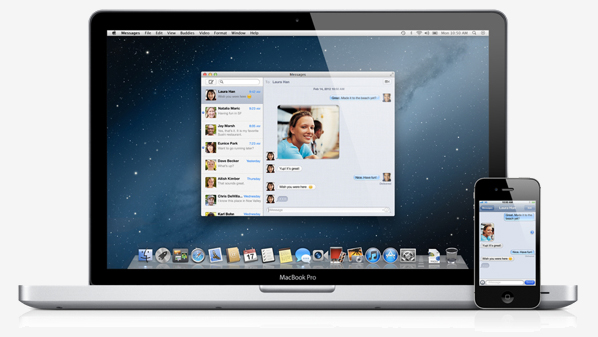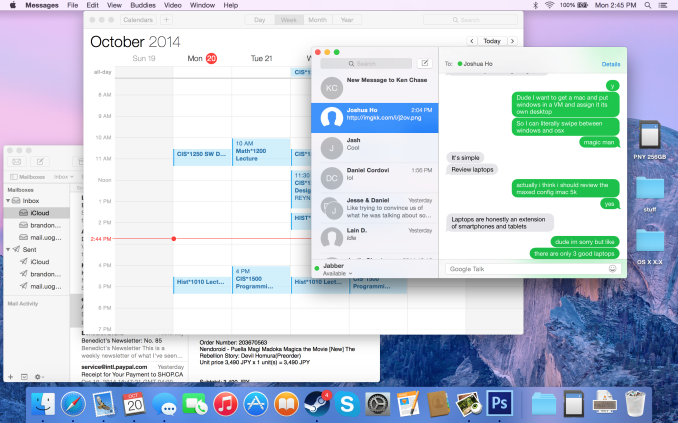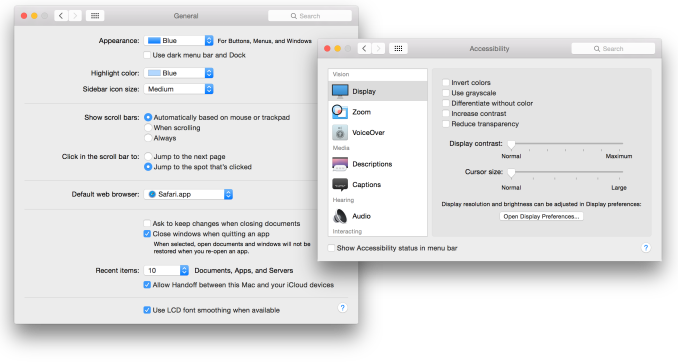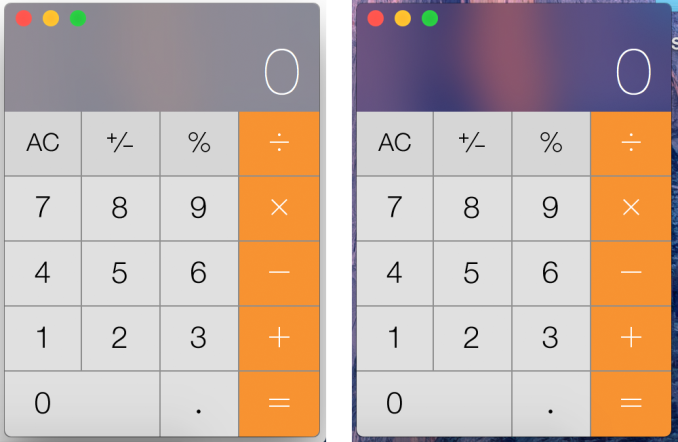A Look At OS X Yosemite And iOS 8.1
by Brandon Chester on October 27, 2014 8:00 AM ESTRethinking OS X
The original interface for iOS was inspired by Apple's Aqua UI, with skeuomorphic elements that mimicked real world objects. Computers have always mimicked the real world to a degree. They have buttons you press, and knobs you turn. The entire desktop metaphor is really just a digitization of the real world office with folders, documents, and a trash can. As computers have evolved and people have become more familiar with them, this overall metaphor has remained for the most part. But many of the visual elements that previously mimicked these real world objects could be simplified to copy in function, but not design. Users who are familiar with computers no longer need a distinct outline and heavy shading to recognize that a button is something they click or tap. They don't want their Calendar and Reminders applications to have leather borders, stitching, and paper like their calendar and date book in the real world, because doing so confines them to the limitations of those physical objects.
iOS 7 was in a sense a rebirth of iOS. The interface that had existed for six years was entirely redone. Core design elements like the homescreen remained, but everything was given a new visual style that eliminated skeuomorphism and ushered in a new era with a new design philosophy for Apple. This style of design is fairly well understood now. iOS makes heavy use of translucency and color. Each application has a primary color throughout which is indicated on its icon. Calendar uses red, Notes uses yellow, etc. With all these massive changes, the future of the design of OS X was uncertain.
One month after we got iOS 7, we got Mavericks. Mavericks was not the major overhaul that iOS 7 was. The visual elements of the operating system were very much the same as previous versions. This can simply be attributed to a lack of engineering resources. Apple's work to redesign iOS most certainly would have began after the departure of Scott Forstall which occurred after the release of iOS 6. Redesigning iOS in less than a year was quite an accomplishment, even with the bugs that were brought along with such a major change. It would have simply been impossible to do the same for OS X within the same period of time.
However, the design in Mavericks did not stand still. While the interface remained the same for the most part, many key applications that implemented skeuomorphic interfaces were redesigned. The leather and stitching was ripped out of apps like Calendar and Notes. The linen was removed from Notification Center and the login screen. These changes were the beginning of the path to what we have now with Yosemite.
For someone used to older versions of OS X, the above interface may seem like a shocking change. But for people who have been exposed to newer versions of iOS, it will actually feel quite familiar. The use of translucency, the flatter interface, and the new system font all draw upon the design principles that were established with iOS 7. It's important to understand what is meant by that. Apple is not establishing a common interface across their devices. OS X and iOS are not the same, and Apple has shown no interest in making them the same. What they are doing is using the same method of design, and the same type of interface elements, to create an experience across those two different operating systems that feels seamless and unified without having to compromise one to fit within the limitations of the other.
I was a fan of Apple's design direction with iOS 7, and so the same has held true for Yosemite. The use of translucency allows the customization of your wallpaper to have an impact on the appearance of the entire operating system. The status bar, the Dock, Launchpad, and any other window that uses translucency can look very different based on the wallpaper that is chosen. Using the new interface tends to have an interesting effect on the user by revealing how dated many parts of the older interface had become. Even users who enjoyed the older design will quickly find themselves questioning how they ever used such a dated interface. It's the same reaction I observed when the iOS userbase moved to iOS 7.
Usability and UI Performance
When the new design of Yosemite was revealed at WWDC 2014, some users voiced concerns that the new design would reduce clarity due to its lighter weighted fonts and heavy use of blur and transparency. On a typical 23" 1080p monitor I haven't noticed any issues reading text that uses the new system font which seems to be a modified Helvetica Neue, but I can see how it may be an issue on non-retina Macbooks where the viewing distance from the display is smaller than a desktop monitor. The blur is also well implemented to preserve legibility. Only the currently active window has the blur effects and transparency enabled. These sections turn opaque when a window is not being used, which means there are not layers upon layers of blur making it difficult to read any text on top of it.
For those who do find that some of the new design choices affect their ability to read or see things, Apple does provide a number of options for accessibility and visual customization. New additions include "Reduce transparency" which removes the translucency effects across the OS, and "Use dark menu bar and Dock" changes the white translucent material in the status bar, the Dock, and Spotlight Search to a black translucent material similar to Notification Center. I tried using the dark mode but I quickly reverted to the original design because the dark menu bar and Dock looked out of place amongst all the white and grey in the rest of the interface.
One issue I have observed with the blur is that windows will show the desktop wallpaper in addition to the applications between which should be blocking the wallpaper from showing through. As you can see above, despite me putting a completely opaque white box behind the calculator, there is still an area with an orange tint in the center. Removing the white reveals that the desktop has the same pattern. During the beta cycle the transparency would only display the wallpaper, and so there was a fix implemented but it introduced a problem of its own. I have seen complaints from other users about this issue, so hopefully it will be remedied in an upcoming update.
Performance is another area of concern with a new design and graphically demanding visual effects like translucency. I have noticed decreases in UI framerate compared to OS X Mavericks based on measurements with Quartz Debug. Overall the OS runs fairly well, but I would be lying if I said it didn't have its issues. Some scrolling lists will regularly drop to somewhere between 30 and 40fps. Scrolling performance in Notification Center is inconsistent, with performance closer to 60fps at some times, and closer to 30fps at others. The worst case I have encountered is the animation for Mission Control which has dropped as low as 5fps when many applications are open. Going forward it will be interesting to see how quickly and to what degree these issues are fixed by Apple.














173 Comments
View All Comments
piroroadkill - Monday, October 27, 2014 - link
Call and SMS handoff to other devices! Woah, we're going back in time to Palm Pre. Still a pretty solid set of ideas around that device...ppi - Tuesday, October 28, 2014 - link
I have SMS synced with my Outlook for a year already (and nobody knows how long our IT witheld that one)Call handoff ... I am not sure I would want it, but as optional feature, why not.
CharonPDX - Monday, October 27, 2014 - link
Continuity looks great!Too bad everyone in my house has one side of the equation too old.
I have an iPhone 5C (good!) with an old 2008 iMac (nope.)
My daughter has an iPad Air (good!) and an iPhone 4 (nope, not even iOS 8,) with a 2008 MacBook Pro (nope.)
My wife has an iPhone 4S (nope - just "call on your Mac",) and a brand new MacBook Air (good!)
So the only person in my family that can make *ANY* use of Continuity/Handoff is my wife, and then only for "call on your Mac" - AKA " Use your Mac as a bluetooth Speakerphone.)
Highhbrid - Tuesday, October 28, 2014 - link
There seems to be a lot of talk about soldered RAM in Mac products. The main reason why you can't upgrade RAM in phones is because the form factor would not be nearly as thin and it wouldn't exactly be an SoC anymore.. form factor is crucial to a handheld device. You have to consider things holistically if you're going to try and compare different fruit here. Very seldom do I observe this amongst convo.I think that with a Macbook Air there is legitimate reasoning for soldering the RAM in place. You and Apple want that device as thin as possible. The thinner you can get it, the lighter too.
With Macbook Pros the argument is a lot weaker. Until those bitches get razer thin (which we're an iteration or two from) removable RAM is easy to pull off. Under a generous, PRIVATE Apple, I believe that they would throw that in.
However when you consider the demographic of Macbook Pro purchasers, it's quite an easy money grab for Apple.
"Higher reliability, better performance, and a more compact design" some will say.
Reliable is in, I put the RAM in wrong? Very rarely do I reset someone's RAM to fix there problem.
Performance: I've seen how fast 16GB @ 2133 MHz goes. I'm not buying it.
Compactness? Refer to the above.
Soldered RAM in a Mac Mini? lol Apple
solipsism - Tuesday, October 28, 2014 - link
You didn't make a valid argument to support your comments that the MBP isn't think enough at this point, you just said it would have to be "razor thin" and eluded to the MBA being thinner.How much space is available right now for removable RAM when you consider the size of the sticks, the channel they sit it, how much much further it will sit below the main board, will that interfere with the bottom casing if it's pressed upon in that area, and will there be enough room for thermals.
I suppose it's possible they could have, but it does come with a cost, which you didn't address at all except to say there is zero benefit.
Highhbrid - Tuesday, October 28, 2014 - link
It's inevitable that they will get thinner. How thin? Who knows. But apparently thin is a big deal to Apple, that was their opening feature to the Air 2 announcement. We will see.I think that the first MBPr could have physically included removable RAM, even if it has to be 1mm thicker. Ultimately, that's Apple decision and they could have included it, I feel.
I didn't say anything about the MBA except that there is a valid reason for soldering the memory into place. The MBP are thin enough IMO
blackcrayon - Tuesday, October 28, 2014 - link
Soldered RAM alone doesn't mean anything. The real issue is that the device will cost more up front. If you won't/can't pay more just buy something else.KoolAidMan1 - Wednesday, October 29, 2014 - link
Soldered RAM on the Mac Mini is terrible. It makes sense if they made it REALLY small like an AppleTV but its the same chassis as before.There's an excuse with the MBA and MBP. This is just stupid.
jaymond - Tuesday, October 28, 2014 - link
When will One Drive or Google Drive copycat the photo features of iCloud Drive? I'm a One Drive user and would love this feature. I'm not willing to pay Apple's prices for cloud storage when I have 1TB free with One Drive with Office 360, but I would like to get my photos off my HDD on my Macbook Air.RichieTech - Wednesday, October 29, 2014 - link
The iMac starts at $2500..... starts! And yet no touchscreen! That's the most asinine thing I've ever heard. I'm sure it looks gorgeous but for that price it should do more and so should the previous models for that matter.The iPad can't form its own network, cant have multiple user accounts and doesn't have its own file structure and cost between $500 to $800.... pffffttt !!! I just spit my beer all over my desk :/
I don't see anything different about OS X(
Thanks iCloud for pics of Scarlett Joe... I'm sure you'll keep my credit card safe with Apple Pay?!
You fear after 13 years, you should be glad after 13 years your moving on!
Nope